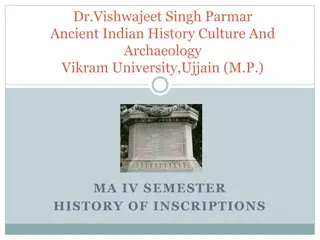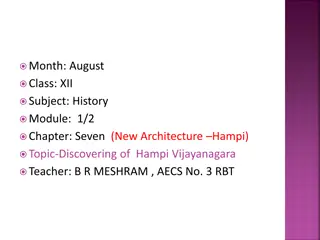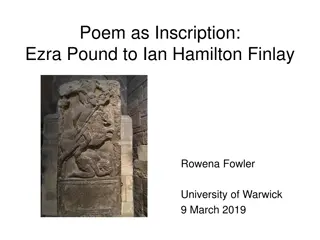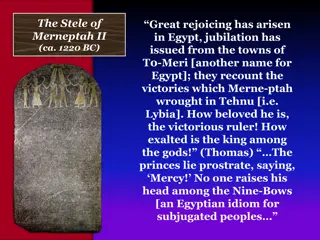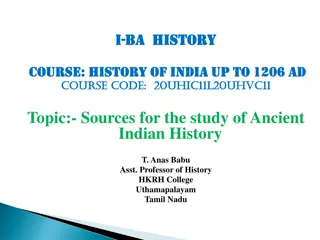Evolution of Inscriptions in Ancient Indian History
The evolution of inscriptions in ancient India reflects a shift from Prakrit to Sanskrit languages over the centuries, marking changes in content, purpose, and classification. Beginning with Brahmi inscriptions, the transition to Sanskrit gradually replaced Prakrit as the language of choice in North
0 views • 12 slides
Sources of Information in Delhi Sultanate Period
The sources of information in the Delhi Sultanate period include inscriptions found on coins, monuments, and tombstones. Historical writings in Persian language provide valuable insights into the administration and history of the Sultanate. Epigraphs and numismatics also play crucial roles in unders
0 views • 8 slides
Understanding the Study of the Past in History: Key Concepts and Methods
Delve into the fascinating realm of history, where the study of the past unfolds through systematic descriptions and analyses of historical events. Explore prehistory, archaeology, inscriptions, epigraphy, monuments, manuscripts, artifacts, numismatics, and more. Discover how the concepts of BC, AD,
2 views • 8 slides
Exploring the Historical Developments from 700 to 1750
The study of history between 700 and 1750 presents a vast array of challenges due to the diverse technological advancements, cultural shifts, and societal changes that occurred during this period. Historians rely on a variety of sources, such as coins, inscriptions, and manuscripts, to understand th
0 views • 11 slides
Discovering the Rich History of Hampi: A Glimpse into the Vijayanagara Empire
Hampi, also known as Vijayanagara, holds the remnants of a once grand empire founded in the 14th century. The discovery of this historical site in 1800 by Colonel Colin Mackenzie marked the beginning of unveiling its treasures. From its origins under Harihara I and Bukka I to the golden era under Kr
0 views • 18 slides
AP World History Interactions in Early Urban Societies
Interactions in early urban societies, as depicted in inscriptions, provide insights into the development of trade networks, social hierarchies, and religious influences. Questions explore the context of inscriptions, social norms, and religious practices during specific historical periods.
0 views • 8 slides
Rise and Legacy of the Later Cholas in South India
The Later Cholas, starting in the 9th Century, established a powerful empire in South India known as the Imperial Cholas. Sources such as inscriptions, monuments, numismatic sources, and literary works provide valuable insights into their history and rule. Monuments like the Brahadeewarar Temple and
0 views • 10 slides
Ashoka: The Emperor Who Embraced Peace and Dhamma
Ashoka, the renowned emperor, transitioned from a military conqueror to a propagator of peace and Dhamma after witnessing the horrors of war. He spread his message through inscriptions in various languages, emphasizing non-violence, respect, and ethics. Despite diverse religions in his empire leadin
0 views • 8 slides
Inscriptions in Words: A Collection of Poetic and Historical Epitaphs
Explore a captivating compilation of inscriptions, ranging from poetic verses by renowned writers like John Donne and William Wordsworth to historical Roman epitaphs. Immerse yourself in the beauty of language and the depth of meaning conveyed through these inscriptions etched in time.
0 views • 19 slides
Unveiling Roman Britain: Lessons on Inscriptions and Everyday Life
Delve into the world of Roman Britain through inscriptions, exploring the lives of its inhabitants. Lesson 2 focuses on deciphering inscriptions to unveil historical insights. Learn to craft historically-valid questions using key words and understand how these artifacts reveal details about everyday
0 views • 13 slides
Life in Auranitis, Jebel Arab Trachonitis, and Leja Batanaea
Auranitis, Jebel Arab Trachonitis, and Leja Batanaea were regions with main cities like Canatha, Adraa, and Bostra. The villages in these areas had no formal plans, with houses similar to those in Dead Cities, featuring storage downstairs, courtyards, flat roofs, and internal staircases. Villagers m
0 views • 12 slides
Discovering Hamedan: Rich History and Natural Wonders
Hamedan, a city in Iran, holds ancient treasures like Ganj Nameh inscriptions and the Stone Lion monument. It boasts a lush mountainous area and is home to the world's largest water cave, Ali-Sadr Cave, attracting thousands of visitors annually. The city's historical and cultural significance, roote
0 views • 11 slides
Ancient Egyptian Stele of Merneptah II and Israel: Historical Inscriptions
The Stele of Merneptah II, dating back to around 1220 BC, provides insights into ancient Egyptian victories in Libya, pacification of the Hittite Empire, and the desolation of Israel. It is one of the oldest references to Israel outside the Bible, shedding light on historical events and the status o
0 views • 6 slides
Sources for the Study of Ancient Indian History: Literary and Archaeological Insights
Exploring the diverse sources available for studying Ancient Indian History up to 1206 AD, including literary works such as Brahmanical texts, epics like Ramayana and Mahabharata, Buddhist and Jaina literature, and archaeological sources like inscriptions, coins, and material artifacts. These source
0 views • 21 slides
Ocular to Imaginary Deixis in Greek Epigram
The seminar held at University College London on 16th May 2018 explored the transition from ocular to imaginary deixis in Greek epigrams. It delved into the significance of visual elements in ancient artifacts and inscriptions, shedding light on the evolution of contextual meanings within Greek art
0 views • 8 slides
Western Influences in Gandharan Art: Greco-Roman Impact and Cultural Blend
Western influences played a significant role in shaping Gandharan art between the 1st century BCE and 7th century CE. The art flourished during the Kushan Dynasty under various influences, notably Greco-Roman. The integration of Western elements transformed the artistic style in Gandhara, creating u
0 views • 8 slides
Insights into Ashoka: The Emperor Who Embraced Peace
Explore the legacy of Ashoka, an influential ruler in history known for his transition towards peace, as seen through his inscriptions and the Mauryan Dynasty. Discover the difference between kingdoms and empires, the significance of dynasties, and the administration in Ashoka's vast empire. Learn a
0 views • 10 slides
